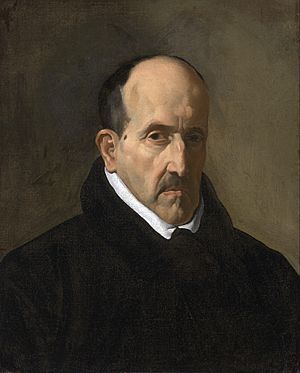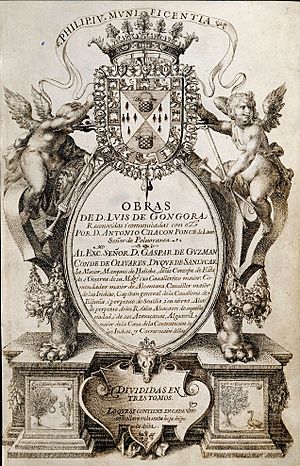Luis de Góngora facts for kids
Quick facts for kids
Luis de Góngora
|
|
|---|---|

Luis de Góngora (1622), in a portrait by Diego Velázquez.
|
|
| Born | Luis de Argote y Góngora 11 July 1561 Córdoba, Spain |
| Died | 24 May 1627 (aged 65) Córdoba, Spain |
| Occupation | Poet, cleric |
| Literary movement | culteranismo |
| Notable works | Las Soledades |
| Signature | |
 |
|
Luis de Góngora y Argote (born Luis de Argote y Góngora; 11 July 1561 – 24 May 1627) was a famous Spanish poet and a Catholic priest. He lived during the Baroque period, a time known for its dramatic and ornate art and literature.
Góngora is considered one of the most important Spanish poets ever. He had a big rivalry with another famous poet, Francisco de Quevedo. Góngora's unique writing style was called culteranismo, also known as Gongorismo. This style was very different from Quevedo's conceptismo.
Contents
About Luis de Góngora
Luis de Góngora was born into a noble family in Córdoba, Spain. His father, Francisco de Argote, was a judge. To get a good education and important jobs in Spain back then, people needed to prove their family had a pure Christian background. So, Luis used his mother's last name, Góngora.
His uncle, Don Francisco, was a church official at Córdoba Cathedral. He gave up his position for Luis, who became a deacon in 1586.
As a church official, Góngora traveled a lot for his duties. He visited many cities in Spain, including Madrid, Salamanca, and Toledo. Around 1605, he became a priest.
He gained many admirers for his poetry. In 1617, he was made an honorary chaplain to King Philip III of Spain. However, he did not hold this important position for very long.
Góngora had a long and famous rivalry with Francisco de Quevedo. Both poets were very talented and witty. They often wrote poems that made fun of each other. Quevedo sometimes criticized Góngora's love for flattery and his passion for card games.
In 1626, Góngora became very ill, which affected his memory. He had to return to Córdoba, where he passed away the next year. He was buried in a chapel at the Córdoba Cathedral.
Soon after his death, a collection of his poems was published. This collection included many sonnets, odes, and longer poems like Soledades and Fábula de Polifemo y Galatea. These two works are key examples of his unique "culteranismo" style. Even Miguel de Cervantes, the author of Don Quixote, thought Góngora was a great poet.
The famous painter Diego Velázquez painted a portrait of Góngora. Records and writings by his rival Quevedo show that Góngora was a friendly and talkative person. He enjoyed card games and bullfights. Even though he was a churchman, he sometimes got into trouble for his love of card playing.
Góngora's Poetic Style
Góngora's style, culteranismo, was very different from conceptismo. Conceptismo focused on clever wordplay and short, witty phrases. Francisco de Quevedo was the main poet who used conceptismo.
The word culteranismo combines "cultivated" and "Lutheranism." Opponents of this style used the name to suggest it was a "heresy" of true poetry. This style aimed to use many words, sometimes to hide or make the meaning more complex. Góngora's poetry was open to new ideas and often included new words.
Góngora loved to use new words that sounded like Latin or Greek. His rivals often made fun of this. Quevedo even wrote a poem listing some of Góngora's fancy words. Góngora also liked to change the normal order of words in his sentences. This was called hyperbaton and was a key part of his poetry.
Many people consider Góngora a genius who greatly enriched the Spanish language. He took words that were not often used and made them popular in his poems. Many of these words are common today, such as adolescente (teenager), brillante (brilliant), construir (to build), and joven (young).
Main Works
Góngora's poems are usually divided into two groups, based on different periods of his writing. His Fábula de Polifemo y Galatea (Fable of Polyphemus and Galatea) and his Soledades (1613) are his most famous and studied works. The Fábula is written in a specific poetic form called royal octaves. The Soledades uses various rhythms and stanzas.
Góngora's Fábula de Polifemo y Galatea (1612) tells a story from Greek mythology. It's about the giant Polyphemus, who falls in love with the beautiful nymph Galatea. However, Galatea does not love him back. At the end of the poem, Galatea's true love, Acis, is turned into a river.
Góngora also wrote Fábula de Píramo y Tisbe (Fable of Pyramus and Thisbe) (1618). This poem is a complex story that makes fun of gossipy and greedy women. He also wrote many sonnets about love, humor, philosophy, and religion. Some of his sonnets even describe his own aging.
He also wrote plays, including La destrucción de Troya and Las firmezas de Isabela.
Góngora did not publish his works himself, but handwritten copies were passed around. In 1627, a collection of his poems was published by Juan Lopez Vicuña. This book helped make Góngora's work widely known.
Góngora and the Generation of '27
The Generation of '27 was a group of Spanish poets and writers who became famous around 1927. They chose this name because it was the 300th anniversary of Góngora's death. This group greatly admired Góngora and worked to bring his complex poetry back into the spotlight.
Dámaso Alonso, a member of this group, studied Góngora's work very closely. He believed that Góngora's difficult language created a world of pure beauty. Alonso showed that Góngora's complex style developed over his entire career, not just in his later years.
Other famous poets from this group, like Rafael Alberti and Federico García Lorca, also praised Góngora. García Lorca even gave a lecture comparing Góngora's use of images in poetry to a film director's use of images in movies.
See also
 In Spanish: Luis de Góngora para niños
In Spanish: Luis de Góngora para niños


